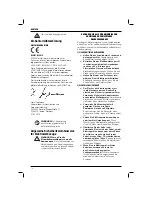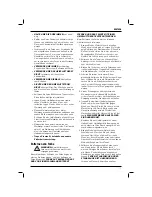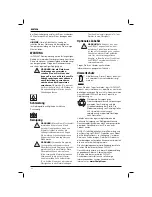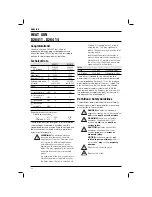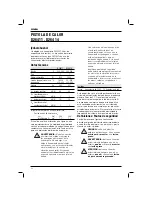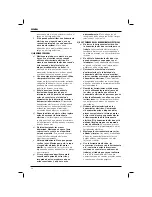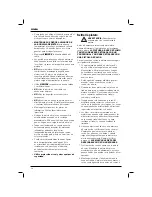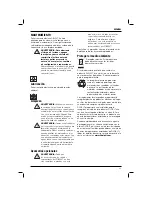
ENGLISH
28
4. Work in one room at a time. Furnishings should
be removed or placed in the center of the room
and covered. Work areas should be sealed
off from the rest of the dwelling by sealing
doorways with drop cloths.
5. Children, pregnant or potentially pregnant
women and nursing mothers should not be
present in the work area until the work is done
and all clean up is complete.
6. Wear a dust respirator mask or a dual filter (dust
and fume) respirator mask. Be sure the mask
fits. Beards and facial hair may keep masks
from sealing properly. Change filters often.
DISPOSABLE PAPER MASKS ARE NOT
ADEQUATE.
7. Use caution when operating the heat gun. Keep
the heat gun moving as excessive heat will
generate fumes which can be inhaled by the
operator.
8. Keep food and drink out of the work area. Wash
hands, arms and face and rinse mouth before
eating or drinking. Do not smoke or chew gum
or tobacco in the work area.
9. Clean up all removed paint and dust by wet
mopping the floors. Use a wet cloth to clean all
walls, sills and any other surface where paint or
dust is clinging.
DO NOT SWEEP, DRY DUST
OR VACUUM.
Use a high phosphate detergent
or trisodium phosphate (TSP) to wash and mop
areas.
10. At the end of each work session put the paint
chips and debris in a double plastic bag, close it
with tape or twist ties and dispose of properly.
11. Remove protective clothing and work shoes
in the work area to avoid carrying dust into
the rest of the dwelling. Wash work clothes
separately. Wipe shoes off with a wet rag that is
then washed with the work clothes. Wash hair
and body thoroughly with soap and water.
IMPORTANT NOTICE
In order for this tool to be an effective paint stripper,
it must produce extremely high temperatures. As
a consequence, the stripper is capable of igniting
paper, wood, paint and varnish residue and similar
materials.
As you become more familiar with the tool and
develop the proper technique, the danger of
accidental ignition will be greatly reduced. In
establishing the proper technique, the best thing to
do is PRACTICE! Work on simple stripping projects,
preferably outdoors, until you get a “feel” for how to
use your stripper safely and effectively.
AS YOU PRACTICE, OBSERVE THE FOLLOWING
PROCEDURES FOR SAFETY
• Always be sure the tool is turned off and
disconnected from power supply when
unattended.
• Clean the scraper blade often during use. Built
up residue on the blade is highly flammable.
• Experiment to find the optimum distance from
the tool’s nozzle to the surface being stripped.
This distance 25.4 mm–50.8 mm will vary
depending on the material being removed.
• Keep the heat gun moving ahead of the scraper
blade at all times.
• As you work, clean up loose pieces of paint as
they accumulate around the work area.
• When working indoors, keep away from
curtains, papers, upholstery and similar
flammable materials.
• Above all, remember that this is a serious tool
that is capable of producing excellent results
when used properly. Practice on simple projects
until you feel comfortable with your stripper.
Only then will you have mastered the proper
technique.
Residual Risks
In spite of the application of the relevant safety
regulations and the implementation of safety
devices, certain residual risks cannot be avoided.
These are:
–
Impairment of hearing .
– Risk of personal injury due flying particles.
– Risk of burns due to accessories becoming hot
during operation.
– Risk of personal injury due to prolonged use.
Markings on Tool
The following pictograms are shown on the tool:
Read instruction manual before use.
Wear ear protection.
Wear eye protection.
Summary of Contents for D26411
Page 1: ...www eu D26411 D26414 ...
Page 3: ...1 Figure 1 a c b d e f g D26411 a c b d e f g D26414 h d ...
Page 4: ...2 Figure 2 Figure 3 Figure 4 A ...
Page 145: ...143 ...
Page 146: ...144 ...
Page 147: ...145 ...

